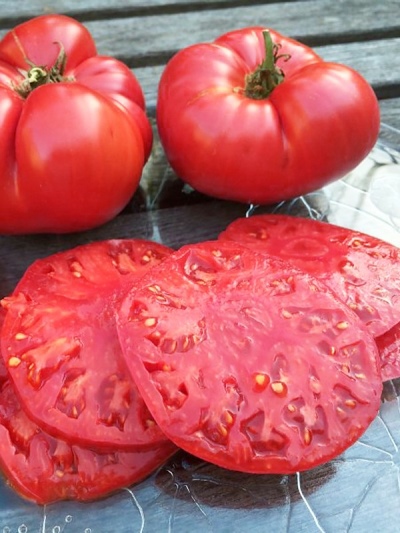
- Authors: Bulgaria
- Name synonyms: Bulgarian Wonder
- Category: grade
- Growth type: indeterminate
- Appointment: fresh consumption, for juice, for ketchup and tomato paste
- Ripening period: mid-season
- Ripening time, days: 110-120
- Growing conditions: for open ground, for film greenhouses, for greenhouses
- Bush size: tall
- Bush height, cm: 180-200
The authors of many varieties of plants seek to give them a fanciful and promising name. In order not to be afraid of problems, you need to study each such type separately. This requirement fully applies to the Bulgarian miracle tomatoes.
Breeding history
The plant belongs to the results of classic Bulgarian breeding. It is impossible to more accurately characterize this moment using publicly available sources.
Description of the variety
The plant has an official synonym used abroad - Bulgarian Wunder. The indeterminate crop is suitable for various types of greenhouses as well as for open land. The height of the bushes can reach 1.8-2 m. Leaves of a regular type are formed on them. Suppliers insist on the very high weather resistance of this crop.
The main qualities of the fruit
Ripe berries are pink or crimson in color. The weight of one specimen varies greatly, from 350 g to 1 kg. In shape, it is close to a flat circle. The ribs on the Bulgarian miracle are not too pronounced. In general, the commercial qualities are high.
Taste characteristics
Most often, the Bulgarian miracle tomato is consumed fresh. But it can also be used to make ketchup, juice, or tomato paste. The pulp of the fruit is sugary and juicy. The official description also mentions her fleshiness and tenderness at the same time.
Ripening and fruiting
The plant belongs to the mid-season group. Therefore, the first fruits can be expected between 110 and 120 days after planting in open land. Harvesting will continue for a long time. This information is not only stated in the description, but also backed up by reviews.
Yield
Decent care allows you to get up to 5.5 kg of fruit per 1 bush. Fee for 1 sq. m sometimes reaches 15 kg. Importantly, the fruits are highly marketable. At normal humidity, it can be expected that there will be no cracking. However, this moment depends little on gardeners.
The timing of planting seedlings and planting in the ground
Usually, seeds are buried in seedling containers 60-65 days before the planned transplantation in open ground. And it is better to appoint this last moment when there will be no frost guaranteed. Gardeners can determine specific points on their own. No one, except them, will take into account the weather better and will not take other circumstances into account either.

Growing tomato seedlings is an extremely important process, because it largely depends on whether the gardener will be able to harvest at all. All aspects must be taken into account, from seedbed preparation to planting in the ground.
Landing scheme
The optimal planting density is 3 bushes per 1 sq. m. It is recommended to adhere to the rule of 700x700 mm. The belt planting method is the most productive. When using it, plant care is especially simplified. Important: you need to choose areas with loosened soil rich in nutrients.

Growing and care
It will be necessary to form the Bulgarian miracle. In this procedure, usually 1 or 2 stems are left. Watering them sparingly is required to ensure that the fruits are not watery and taste good. Top dressing can be done both with organic and mineral compounds. The responsiveness of plants in both cases will be optimal.
Increasing the productivity of tomato The Bulgarian miracle is achieved by spraying with boric acid. Nursing at the seedling stage is not too difficult. It is also watered in moderation. The air temperature must be maintained between 24 and 28 degrees. Seedlings must dive, and when 2-3 true leaves appear, they are transplanted into a more spacious container.
As predecessors, they show themselves well:
cucumbers;
zucchini;
carrot;
parsley;
Dill.
Mineral fertilizers are used twice or three times during the growing season. Specifically, you can only say taking into account the state of a particular plant. Organic dressings are used twice. Among them, the best are chicken droppings and humus. A garter at the stage of fruit setting and before the end of the growing season is required, otherwise the bush may collapse.




A plant needs different micronutrients at each stage of growth. All fertilizers can be divided into two groups: mineral and organic. Folk remedies are often used: iodine, yeast, bird droppings, eggshells.
It is important to observe the rate and period of feeding. This also applies to folk remedies and organic fertilizers.


Review overview
Many gardeners, having tried the Bulgarian miracle, no longer remove it from their garden.Such a crop can be grown for many years with a stable result. They note full compliance with the description and a very pleasant taste. There are practically no negative assessments. It is worth noting only that not everyone manages to achieve high fertility on the site.

























































































